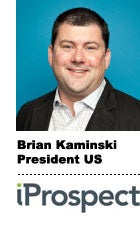 Speak the name iProspect and what’s the first thing that comes to mind? If you were around during the first wave of online marketing, the answer is certainly “search.” The agency was one of the first independent search marketing agencies to go global with offices in Europe, Asia, and elsewhere before its 2004 acquisition by Aegis.
Speak the name iProspect and what’s the first thing that comes to mind? If you were around during the first wave of online marketing, the answer is certainly “search.” The agency was one of the first independent search marketing agencies to go global with offices in Europe, Asia, and elsewhere before its 2004 acquisition by Aegis.
But iProspect is repositioning itself for a world defined by the interplay of search with other channels including display, mobile, and social. It’s now very focused on the growing challenge around conversion attribution.
AdExchanger spoke with US President Brian Kaminski.
iProspect was one of the first global search agencies. What is it today?
We really consider ourselves a global digital performance agency. And that is obviously a very loaded yet somewhat meaningless statement, all at once. Basically, in a nutshell, we view ourselves as an agency that helps our clients identify where their consumers are living, breathing, and playing online and help to harvest the intent that those users have and help to drive connections and engagements with our clients.
We do that across a variety of channels. We still consider ourselves very much search at the core. We’re very proud of our nerdy data and search heritage. And we think that positions us well in a world that is so driven by convergence, consumers, and data.
That allows us to play in SEO, paid search, display media. I know anyone with a pulse will tell you that they’re doing work in mobile and social. We’re doing work in mobile and social around driving consumer connection. We’re not steering from our roots and trying to be everything to everybody in terms of social and mobile.
How do you play in programmatic media?
We’re doing a very strong job today in the RTB world of buying for the bottom of the funnel. The similarities with search are just off the chart, and that was a very comfortable place for us to move into. The evolution right now is understanding how to get more efficient and use the tools at our disposal to drive more cost effective and meaningful consumer engagement.
Our clients are in very different stages, from still scratching their head to crawling to walking to really advanced implementations, on the attribution front. And so as you start to understand your overall consumer engagement ecosystem, [programmatic] starts to become a much more interesting place, because you’re potentially buying a display placement on a certain site against a certain user segment because you know that that is driving some form of engagement. It’s maybe driving search activity. It’s maybe driving them to engage with video content on your site. But you can apply intelligent metrics to evaluate how smart you’re doing that, as opposed to, “We spent this amount of money on brand, and we can’t really determine the impact of that.”
Attribution is such a critical element of being able to be a smarter marketer, and we’re excited about what we’re doing with it. Some of them are still in very infant stages, but there’s a lot of interesting work being done. Anyone who tells you they’ve got it figured out should probably take a second look.
Do you handle attribution modeling in‑house or work with partners?
We are in the agency business but we are not a technology company. We work with Visual IQ. We work with Adometry. We work with ClearSaleing. We use them from a tracking perspective, and we have numerous implementations across those guys, across our clients. The value that we add is not necessarily in collecting and storing the data, but in mining the data for insights.
You may or may not be surprised, but a large number of customers say, “We have an attribution solution in place, so we’re covered on that front.” And when we start to ask them probing questions, like, “What do you do with it?” You get answers like, “Well, Joe logs into it every Friday and pulls the report.” Which causes me to rip all of my hair out in the middle of the meeting, because if they’re not actually using it. It’s sort of like, wow, you’ve got this Ferrari in the garage and you stop by and look at it every once in a while to make sure it’s still sitting there.
Our role is to harvest and use the insights to run our campaigns, but also to help clients be smarter in other channels. I believe it is the responsibility of more measurable media to inform less measurable media. And so, when you’re looking at things like email or other channels, I think that to run those channels as successfully as you can, you would be wise to leverage data that you have from other channels.
How might that play out for a specific client?
It’s a matter of understanding the business goals, working with the client to make a technology decision, and then starting to build our campaigns and build our tests around wanting to test specific hypotheses. That’s a good way to start, understanding the data that’s available and getting the client organization to embrace that change.
A hypothesis might be: your search query volume is declining. Through that, and maybe some social metrics, your awareness is not where we want it to be. So we’re going to run some campaigns to spark awareness and connections, and we want to measure the impact that has downstream ‑ the spillover effect, if you will.
Clients sometimes struggle to dive in and adopt attribution — or I guess the better way to think about it is, attribution‑led decision making. They struggle to embrace that wholeheartedly, so we try to ease everybody’s comfort by using it on certain areas of the business. For example, we alter our mix around mobile for this particular product launch, or we focus more heavily on advertising near your retail stores versus not. And we work through some test cases to develop initial learnings. Then we slowly get the organization to embrace attribution‑led decision making.
Are there vertical categories where iProspect is especially strong?
Historically we’ve had a very strong presence and continue to, in retail, both luxury and big‑box. Retail embraces the notion of performance, and we’re working with our retail clients to help them understand the role we play well beyond “give us a dollar and we’ll give you five back.” Helping them to solve bigger business problems, right? That’s an evolution that we are making.
I think we’ve done fairly well in the travel and hospitality sector as well. And then we have a particularly strong health sciences group. That’s more of an earned‑media practice than a bought‑media practice at this point, but we do work with some of the larger pharmaceutical organizations in the U.S.
How do you view the Facebook opportunity?
I still have way too many clients who want to put their ROI for Facebook against their ROI for Google. And when you do that, it’s not going to be pretty. It’s really not.
They’re not comparable. I don’t know how else to say it. The struggle that everybody’s having with Facebook is how to leverage things, because there’s huge value. I’m not going to sit here and say, “Facebook’s not valuable because we don’t see huge click‑through rates.” You typically don’t. Or you can’t say Facebook’s not valuable because you don’t see people buying stuff from Facebook. It’s not supposed to be that way. I have the same circular arguments about mobile, when a client comes in and says, “My ROI on my mobile commerce isn’t as good as my desktop ROI.” It’s sort of like, yeah, but the experience is totally different, so we’ve got to move away from that.
Facebook is hugely valuable. It just needs to be leveraged in the right way. It’s an amazing vehicle for driving engagement — through ads, but also through just leveraging the entire Facebook experience.
One thing that plagues Facebook, and I forget where I heard this stat, but most big companies have about three-and-a-half agencies that touch their Facebook experience. And so you wonder why most Facebook experiences are disjointed, from the ad component to the promotional component. A lot of times, one agency runs promotions or deals on Facebook, one does content, etc.
What’s your involvement with Dentsu’s AMNET trading desk, and what’s theirs with iProspect?
AMNET is the Aegis trading environment, and it’s an environment that we use very frequently to buy audiences, to do a lot of our RTB work. It plays a strong role in what we’re doing for a good number of advertisers. It’s certainly not something that we have 100‑percent adoption on or that we require adoption on. It’s another tool that we have to accomplish whatever goals and objectives our clients have for us. But it is really nice to have that expertise there, to really be able to tap into, because, yeah, there’s some similarities with some other things that we do, but there’s also a lot of differences. And so, being able to have a team of experts is an amazing resource for us and for our clients. That’s really, ultimately, how we look at it is, really, another partner there to help us get the job done.
Do you also have your own direct licensing relationships with DSPs, separate from AMNET’s?
We do. We have to wear a lot of hats, because sometimes we are the soup‑to‑nuts digital performance. Sometimes we’re managing media and someone else is managing paid search, sometimes it’s the inverse. Sometimes there’s one agency, sometimes there’s 64,000 agencies in the mix. Each one of our clients is, frankly, a pretty different scenario. There’s also different levels of maturity. We still have a lot of clients who are figuring search and more conventional media out and aren’t necessarily on the course, today or tomorrow, for more integrated solutions. It’s the fascinating yet maddening part of our world, that nothing’s ever the same.
What else are you focused on?
One thing that I’m semi‑obsessed with lately is just the role of technology in our clients’ marketing environment. Clients are screaming right now for help, because there’s so many pieces of technology and they’re changing so quickly. Our view of the world here is that one of the value‑adds or one of the areas of expertise that we bring to our clients and we aspire to bring more of in the future is just, really, an understanding of technology. I think, from our perspective, we are not shackled by having our own technology. So we don’t have a bidding agent. We don’t have an analytics platform. So for us, we’ve developed a whole bunch of criteria and metrics and evaluation elements to help clients grasp that technology recipe, I call it, the understanding of the pieces of technology they’re going to have and how they all play together. I think that an area that’s starting to get more attention from marketers, and I think it’s really important to understand that they’ve got the right types of technology.
There’s a great debate I had with a client yesterday about using their paid search platform to bid on Facebook, versus using a platform that was designed and built to bid on Facebook, and the pros and cons of that. The line between the technology side of the house on the client side and marketing side of the house are becoming so intertwined.













